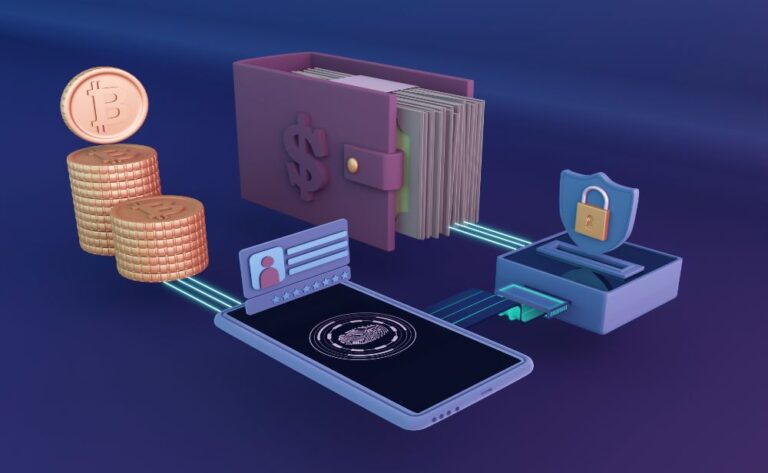What Exactly Is Cryptocurrency?

Cryptocurrency is a decentralized, blockchain-based digital currency. There are more than 19,000 different cryptocurrencies in circulation. You may be aware of Bitcoin and Ethereum, the most popular variants.
How do cryptocurrencies operate?
A cryptocurrency is a decentralized, digital, and encrypted mode of exchange. Unlike the U.S. Dollar or the Euro, there is no central authority responsible for managing and maintaining the value of cryptocurrencies. Instead, these tasks are divided widely among cryptocurrency users via the internet.
Although cryptocurrencies can be used to purchase conventional goods and services, most individuals invest in them similarly to stocks or precious metals. Cryptocurrency is a fresh and interesting asset class, but purchasing it is dangerous since you must conduct extensive research to fully comprehend how each system operates.
In 2008, Satoshi Nakamoto published a paper entitled “Bitcoin: A Peer-to-Peer Electronic Cash System” in which he defined the fundamentals of Bitcoin. The idea was characterized by Nakamoto as “an electronic payment system based on cryptographic evidence rather than trust.”
This cryptographic evidence consists of verified and recorded transactions on a blockchain.
What Does Blockchain Mean?
A blockchain is an open, decentralized ledger that records transactions using computer code. In practice, it resembles a checkbook that has been distributed across multiple computers worldwide. Transactions are recorded in “blocks” which are then connected to a “chain” of previous bitcoin transactions.
“Imagine a book in which you record your daily expenditures,” says Buchi Okoro, CEO, and co-founder of the African bitcoin exchange Quidax. Each page is analogous to a block, and the collection of pages constitutes a blockchain.
With a blockchain, each user of a cryptocurrency has their own copy of this book to produce a centralized ledger of all transactions. Each new transaction is recorded as it occurs, and every copy of the blockchain is instantaneously updated with the new data, ensuring that all records are identical and correct.
Each transaction is validated using a technique such as proof of labour or proof of stake to prevent fraud.
Proof of Work as opposed to Proof of Stake
Proof of work and proof of stake are the two most prevalent consensus procedures used to validate transactions prior to their addition to a blockchain. Verifiers are then compensated for their work with cryptocurrency.
Evidence of Work
“Proof of work is a mechanism for confirming transactions on a blockchain in which an algorithm generates a mathematical puzzle for computers to solve,” explains Simon Oxenham, social media manager at Xcoins.com.
Each participating computer, also known as a “miner,” solves a mathematical challenge that verifies a set of transactions, known as a block, and then adds them to the blockchain’s distributed record. The first computer to accomplish this correctly gets awarded a modest sum of cryptocurrency. For instance, Bitcoin rewards a miner of 6.25 BTC (about $200,000) for verifying a block. The competition to solve blockchain riddles can necessitate a substantial amount of computing power and electricity. Taking into account the expenses of electricity and computer resources, miners may just break even with the cryptocurrency they earn for confirming transactions.
Evidence of Stake
Proof of stake is used by several cryptocurrencies to lower the amount of processing power required to verify transactions. Proof of stake limits the number of transactions any participant can verify to the amount of cryptocurrency they are willing to “stake,” or temporarily lock up in a community safe in order to participate in the verification process.
Okoro states, “It’s almost like bank collateral.” Each individual who wagers cryptocurrency is eligible to verify transactions, however, the likelihood of being selected normally increases with the amount you put up.
“Because proof of stake eliminates energy-intensive equation solving, it is far more efficient than proof of work, allowing for shorter transaction verification/confirmation times,” explains Anton Altement, chief executive officer of Osom Finance.
In contrast, the average Bitcoin transaction time is at least ten minutes. Compare this to Solana, a crypto platform that utilizes the proof-of-stake system, which processes over 3,000 transactions per second (TPS) on average, making it far faster than the Bitcoin network.
On the horizon, Bitcoin’s chief competitor, Ethereum, will completely adopt a proof-of-stake system. Ethereum claims that its energy consumption will reduce by 99.5% after “the final chapter of proof of work on Ethereum” is closed.
Role of Consensus in Cryptography
Proof of stake and proof of work rely on consensus techniques for transaction verification. This implies that while each utilizes individual users to verify transactions, each transaction must be reviewed and approved by the majority of ledger holders.
How Can Cryptocurrency Be Mined?
Mining is the process by which new units of a cryptocurrency are added to the circulation, typically in exchange for confirming transactions. It is theoretically conceivable for the typical person to mine cryptocurrency, but with proof-of-work systems like as Bitcoin, it becomes progressively harder.
“As the Bitcoin network expands, it becomes increasingly complex, necessitating greater processing capacity,” explains Spencer Montgomery, founder of Uinta Crypto Consulting. It used to be possible for the typical customer to do this, but now it’s simply too pricey. Too many individuals have perfected their tools and technology to outcompete the competition.”
Proof-of-work cryptocurrencies demand enormous amounts of energy to mine as well. Bitcoin mining, for instance, consumes electricity at an annually rate of 127 terawatt-hours (TWh), which is greater than Norway’s whole annual electricity usage.
While it is impractical for the common individual to earn cryptocurrency by mining in a proof-of-work system, the proof-of-stake model requires less powerful computers as validators are selected randomly based on the amount they stake. To join, you must already be in possession of cryptocurrency. (Without cryptocurrency, you have nothing to stake.)
How Can Cryptocurrency Be Used?
While crypto can be used to purchase a variety of products and services, particularly with Litecoin, Bitcoin, and Ethereum, it can also be used as an investment alternative to stocks and bonds.
Bitcoin is a secure, decentralised currency that has become a store of value comparable to gold, according to David Zeiler, a cryptocurrency analyst at the financial news site Money Morning. Some individuals refer to it as ‘digital gold’.
How to Use Cryptocurrency to Make Secure Transactions
Using crypto to facilitate secure purchases relies on the item being purchased.
If you’re attempting to pay using cryptocurrencies, you’ll likely require a cryptocurrency wallet. A “hot wallet” is a sort of wallet consisting of a software application that interacts with the blockchain and enables users to transfer and receive their stored bitcoin.
Keep in mind that transactions are not immediate because they must be validated by some process.
Top Cryptocurrency Markets
Through crypto exchanges like Coinbase, Kraken, and Gemini, cryptocurrencies can be purchased. They offer the opportunity to exchange Bitcoin, Ethereum, and Dogecoin, among other prominent cryptocurrencies. However, they may also have restrictions. You must determine if your exchange provides the appropriate crypto-to-crypto pairing in order to make a buy.
For instance, you can utilise your cache of the crypto stablecoin USD Coin to purchase Ethereum on Coinbase Exchange.
“It was originally extremely difficult, but is now relatively simple, even for crypto newbies,” explains Zeiler. “An exchange like Coinbase accommodates nontechnical individuals. It is simple to create an account and link it to a bank account.”
Be mindful of fees, though, as some of these exchanges impose excessively large expenses on purchases of modest amounts of cryptocurrency.
Investing in Cryptocurrency
Some brokerage sites, like Robinhood, Webull, and eToro, permit crypto investments. In addition to cryptocurrency exchanges.
Keep in mind that purchasing individual cryptocurrencies is comparable to purchasing individual equities. They are essentially risk assets.
If you desire exposure to the cryptocurrency market, you might invest in individual crypto company stocks. Zeiler adds that there are a few Bitcoin mining stocks, such as Hive Blockchain (HIVE). “If you want crypto exposure with less risk, you may invest in IBM, Bank of America, and Microsoft, who are using blockchain technology.”
How does the value of cryptocurrency grow?
To illustrate how various cryptocurrencies can rise in value, let’s examine Bitcoin, the crypto industry’s gold standard.
The value of Bitcoin nearly doubled in 2020, completing the year around $28,900. By April 2021, the price of BTC had more than doubled since the beginning of the year, but by July, all of these gains had been erased. The price of Bitcoin then more than doubled again, reaching an intraday high of almost $68,990 on November 10, 2021, before falling to over $46,000 by the end of 2021. At the beginning of June 2022, Bitcoin trades for little more than $31,000 per coin.
Bitcoin has appreciated by more than 1,000% over the previous five years, while the original cryptocurrency is down by 35% year to date.
Should You Make Cryptocurrency Investments?
Regarding bitcoin investments, experts have conflicting viewpoints. Because cryptocurrencies are highly speculative investments with the potential for extreme price fluctuations, several financial professionals do not recommend investing.
Pros and Cons of Cryptocurrency
Peter Palion, a certified financial planner (CFP) from East Norwich, New York, believes it is safer to continue with government-backed currencies, such as the U.S. dollar.
“If you have U.S. dollars in your financial reserves, you know you can pay your mortgage and utility bill,” adds Palion. “When examining the last 12 months, Bitcoin resembles my latest EKG, while the U.S. dollar index is essentially a flat line. Something that decreases by fifty percent is only acceptable for speculation.”
Ian Harvey, a New York-based financial advisor, assists clients who have a particular interest in cryptocurrencies to invest in the asset class. “The weight in a client’s portfolio should be substantial enough to feel relevant without derailing their long-term objective,” adds Harvey.
Regarding the amount to invest, Harvey asks investors what proportion of their capital they are ready to lose if the investment fails. “It might range from 1% to 5%, or even 10%,” he explains. “It depends on how much they now have and how much they stand to lose from a loss viewpoint.”





